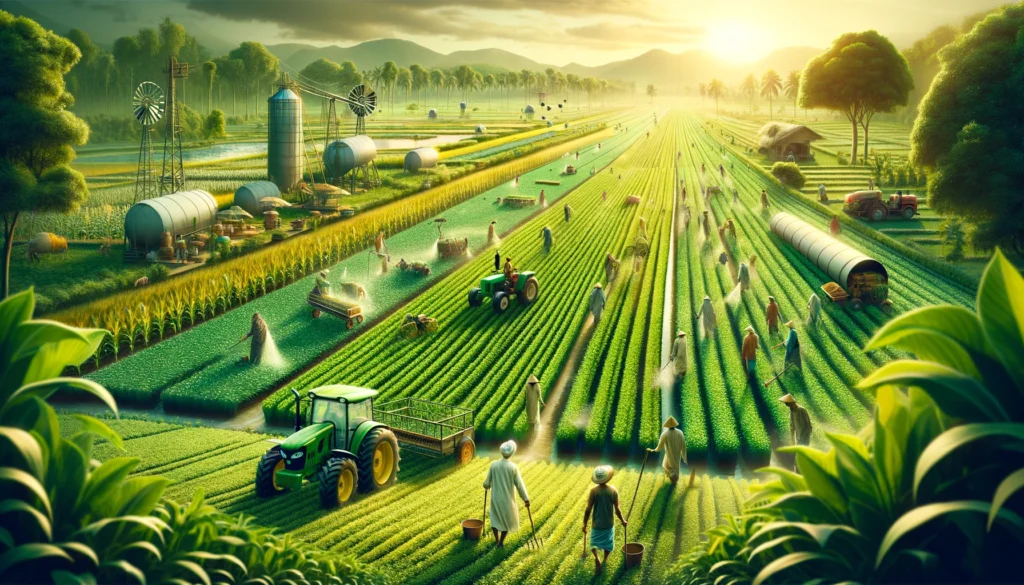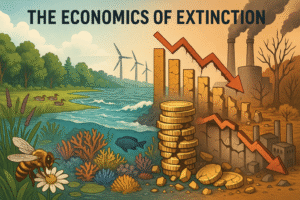Welcome to our fourth installment of “India’s Economic Odyssey: Past to Present.” In this segment, we delve into the pivotal era following India’s independence in 1947—a time of rebuilding, strategic planning, and laying the groundwork for future prosperity. This journey from a nascent nation grappling with the aftermath of colonial rule to establishing a self-reliant economy is not just inspiring but also a testament to India’s resilience and strategic foresight.
Overcoming Post-Independence Challenges
When India emerged as an independent nation on August 15, 1947, it was met with a plethora of immediate and long-term economic challenges. The joy of freedom was tempered by the realities of partition—a monumental event that led to widespread displacement, loss of life, and a significant upheaval in the socio-economic fabric of the country.

The partition with Pakistan resulted in a massive movement of populations across newly drawn borders, with millions seeking new homes, livelihoods, and stability in the aftermath. This mass migration strained the resources, infrastructure, and administrative capabilities of the nascent nation.
Moreover, India inherited an economy that had been structured for the benefit of the British Empire. The colonial legacy included a weakened industrial base, a predominantly agrarian economy subject to the vicissitudes of monsoon rains, and extensive socio-economic disparities. The urgent need for food security, employment generation, and industrial development became paramount. The country faced the dual task of repairing partition-induced damages and building a robust economy capable of sustaining its vast population.
Strategic Economic Planning
In response to these daunting challenges, India adopted a model of strategic economic planning, drawing inspiration from the Soviet Union’s planned approach to economic development. The government instituted a series of Five-Year Plans, a novel concept aimed at organized and phased development across key sectors of the economy.

The first Five-Year Plan (1951-1956) focused primarily on agriculture, aiming to increase food grain production and achieve self-sufficiency in food. Investment in irrigation, land reforms, and agricultural research were prioritized to revive an agrarian economy left vulnerable by colonial policies and partition. The success of this plan laid the groundwork for addressing the immediate concern of food security and established a precedent for systematic economic development.
Subsequent plans shifted focus towards industrialization, recognizing the critical role of a diversified industrial base in achieving long-term economic independence and growth. The emphasis was on the development of heavy industries such as steel, energy, and transportation. This period saw the establishment of public sector undertakings (PSUs), state-owned enterprises that spearheaded the industrialization drive. These PSUs not only played a crucial role in building industrial infrastructure but also in generating employment and fostering technological capabilities within the country.
The strategic economic planning approach adopted by India in the post-independence era was instrumental in laying the foundations for a self-reliant economy. By focusing on key sectors sequentially—starting with agriculture and moving towards industrialization—the country embarked on a path of holistic development, setting the stage for future economic policies and reforms.
The Green Revolution: Transforming Agriculture
The Green Revolution in the 1960s stands out as a landmark period in India’s agricultural history, fundamentally transforming the sector and marking the country’s transition towards agricultural self-sufficiency. This transformative phase was initiated in response to the recurring famines and food shortages that plagued India in the years following independence. The introduction of high-yielding variety (HYV) seeds, alongside advancements in irrigation techniques, and the use of chemical fertilizers and pesticides, led to a significant increase in food grain production, particularly wheat and rice.

The success of the Green Revolution was most pronounced in states like Punjab, Haryana, and Uttar Pradesh, where these new agricultural practices were adopted extensively. The initiative not only helped India achieve self-sufficiency in food grains but also transformed the rural economy, increasing the income of farmers and reducing the country’s dependence on food imports. However, it’s important to note that the Green Revolution also brought with it challenges, including environmental degradation, increased use of water resources, and disparities in growth between regions that could and could not adopt the new technologies.
Industrialization and the Public Sector
Post-independence, India embarked on a path of industrialization with a focus on building a strong public sector. The government’s strategy was to establish public sector undertakings (PSUs) in key industries such as steel, coal, oil, and telecommunications. These PSUs were envisioned as the engines of growth that would drive the country’s industrialization, create employment, and contribute to the development of a self-reliant economy.
This emphasis on the public sector led to the establishment of iconic PSUs like Steel Authority of India Limited (SAIL), Bharat Heavy Electricals Limited (BHEL), and Indian Oil Corporation Limited (IOCL). These enterprises not only played a pivotal role in India’s industrial growth but also in the development of infrastructure and technological capabilities. Over time, the public sector became a significant employer and contributed substantially to the country’s GDP. However, by the late 1980s and early 1990s, many PSUs began to face issues of efficiency and profitability, prompting a reevaluation of their role in the economy.
Economic Reforms and Opening Up
The economic reforms of 1991 marked a watershed moment in India’s economic history, signaling a shift from a predominantly state-controlled economy to a more open and market-driven one. Faced with a severe balance of payments crisis, India embarked on a series of liberalization, privatization, and globalization (LPG) reforms. These reforms aimed to reduce the government’s role in the economy, attract foreign investment, and integrate India into the global economy.

Key measures included the deregulation of industries, reduction of import tariffs, simplification of investment procedures, and the privatization of several PSUs. These steps not only helped stabilize the economy in the short term but also set the stage for sustained growth and development. The opening up of the economy spurred foreign investment, revitalized the private sector, and led to the emergence of new sectors such as information technology (IT) and services, which would become significant drivers of India’s economic growth in the years to come.
The impact of these reforms has been profound, with India emerging as one of the fastest-growing economies in the world. However, the transition also presented challenges, including increased competition for domestic industries and disparities in growth across sectors and regions. Despite these challenges, the economic reforms of 1991 are widely regarded as a turning point that ushered in a new era of economic prosperity for India.
Author’s Note
As we conclude our exploration of India’s post-1947 economic journey, we’re reminded of the nation’s strategic approach to overcoming challenges and seizing growth opportunities. From stabilizing the economy and ensuring food security to embracing globalization and fostering innovation, India’s journey is a remarkable story of resilience and transformation.
G.C., Ecosociosphere contributor.
References and Further Reading
- “India After Gandhi” by Ramachandra Guha offers a comprehensive overview of India’s journey post-independence.
- “The Making of Modern India: Amidst the Making of Modern World” by Gazal Bharadwaj provides insights into India’s economic policies and growth trajectory.
Stay tuned for our next post, where we delve deeper into the liberalization era and India’s emergence as a global economic powerhouse.





Comments
Thank you for your sharing. I am worried that I lack creative ideas. It is your article that makes me full of hope. Thank you. But, I have a question, can you help me?
Your article helped me a lot, is there any more related content? Thanks!
Your article helped me a lot, is there any more related content? Thanks!
Thanks for sharing. I read many of your blog posts, cool, your blog is very good.
Thank you for your sharing. I am worried that I lack creative ideas. It is your article that makes me full of hope. Thank you. But, I have a question, can you help me?
Can you be more specific about the content of your article? After reading it, I still have some doubts. Hope you can help me.
I don’t think the title of your article matches the content lol. Just kidding, mainly because I had some doubts after reading the article.
Thanks for sharing. I read many of your blog posts, cool, your blog is very good.
Can you be more specific about the content of your article? After reading it, I still have some doubts. Hope you can help me. https://accounts.binance.com/ar/register?ref=V2H9AFPY
Your point of view caught my eye and was very interesting. Thanks. I have a question for you.
Thanks for sharing. I read many of your blog posts, cool, your blog is very good.